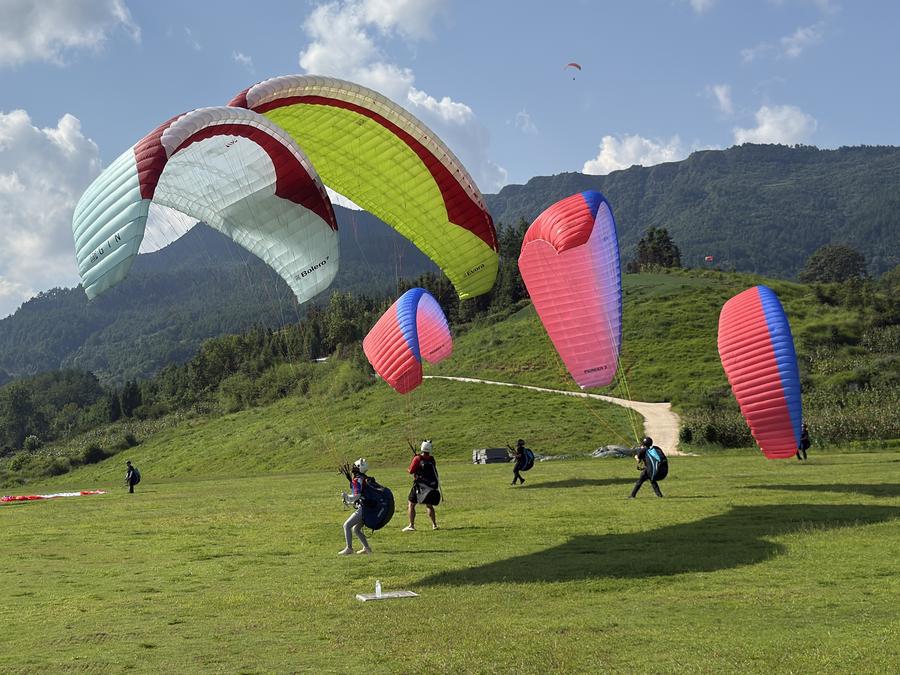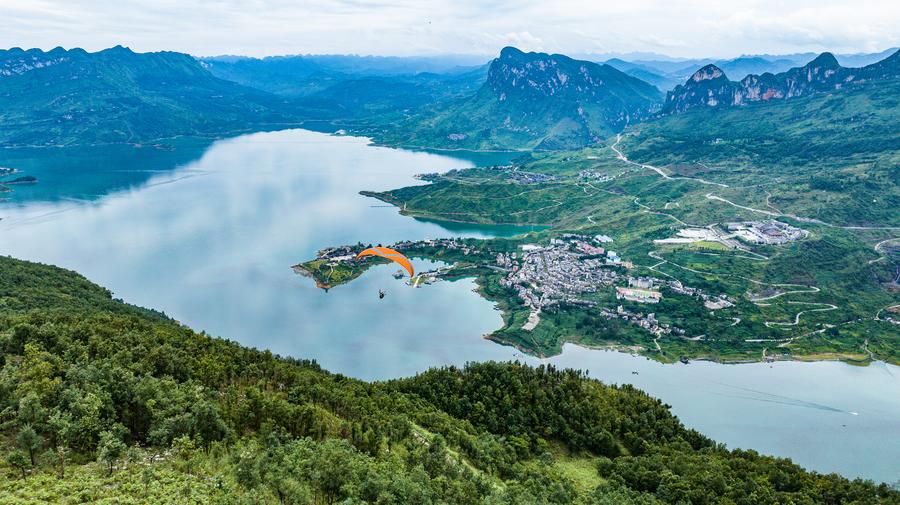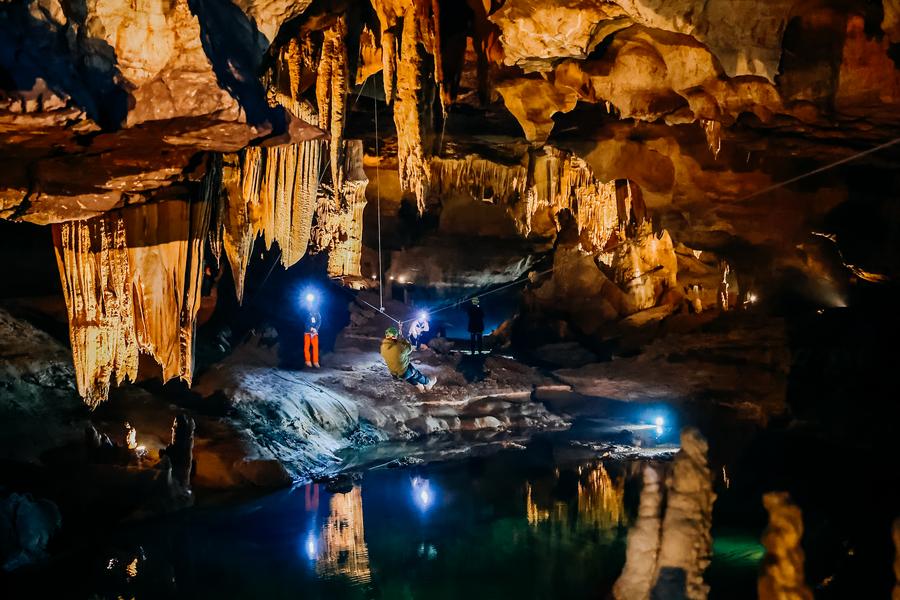

Most areas of southwest China's Guizhou Province are characterized by karst terrain, which has helped the province emerge as a dream destination for Chinese travelers this summer.
Paragliding is a popular low-altitude tourism activity in Guizhou, which has the potential to become the Chinese equivalent of Fethiye, the globally renowned Turkish paragliding destination.
Guizhou's karst-cave tourism now generates around 1 billion yuan (about 140 million U.S. dollars) annually, and in the first half of this year, the province saw an 8.2 percent increase in visitors who spent 10.6 percent more than the same period last year.
GUIYANG, Aug. 12 (Xinhua) -- Amid the scorching summer, the karst landscape in southwest China's Guizhou Province comes alive as a refreshing escape, with paragliders drifting across the azure sky, and deep below, headlamps flickering in the stillness of ancient caves.
Guizhou is fast emerging as a dream destination for Chinese travelers thanks to the unique mix of scenic beauty and opportunities of heart-pounding adventures.

People take part in a paragliding training course in Huangping County, southwest China's Guizhou Province, July 30, 2025. (Xinhua)
AERIAL PLAYGROUND
At the Zangke River International Paragliding Base, mist hung over Mount Laowangshan as paragliding instructor Sun Tao spoke over the walkie-talkie. "Good job. Let's run through the braking once more," he said, eyes fixed on a trainee soaring above.
Moments later, the trainee's parachute suddenly jolted. The reserve chute was activated, and the trainee touched down safely in the river, where a rescue boat was already speeding toward them.
What might seem terrifying to outsiders is just routine here. Zangke has emerged as a premier site in China for SIV, short for Simulation d'incident en vol' in French, which refers to simulating unstable in-flight situations, an advanced course that trains pilots how to handle midair emergencies.
"Everyone I know in the paragliding community recommended Zangke for SIV," said Ma Yongliang, a senior high school teacher from east China's Shandong Province, who finally completed the course he had planned for two years. "The instructors are top-notch, and 10 days of intense training here surpasses anything I would have learned elsewhere."
With a 700-meter vertical drop and roughly 300 flyable days a year, Zangke has become a magnet for paragliding pilots from across China and beyond. Since 2013, the "Soaring Guizhou" Zangke River International Paragliding Invitational has drawn athletes from Türkiye, the United Kingdom, Switzerland and other countries.
Brazilian paragliding enthusiast Silvio Silva, who now lives in south China's Guangdong Province, recently visited Zangke for a weeklong SIV training course. "The scenery is stunning, the safety protocols are tight, and the instructors are incredibly professional," Silva said.
"Young people make up more than half of our tandem flight participants, and that number has been growing, especially in the last two years," Sun added. "A lot of them come with friends or family. After Mount Laowangshan went viral online in 2024, even more people discovered our paragliding program and decided to give it a try."
According to Fan Xiaohui, executive vice president of the provincial low-altitude sports association, paragliding is a popular low-altitude tourism activity in Guizhou, which has the potential to become the Chinese equivalent of Fethiye, the globally renowned Turkish paragliding destination.

A tourist experiences paragliding in Liuzhi special district of Liupanshui City, southwest China's Guizhou Province, July 9, 2025. (Xinhua/Tao Liang)
Most areas of Guizhou are characterized by karst terrain. The steep cliffs and significant elevation differences of the karst peaks naturally create stable updrafts and open airspace, meeting the strict requirements for takeoff slopes and airflow corridors for paragliding, explained Li An, head of Guizhou Huangping An'an Sports Co., Ltd.
Moreover, the "bird's eye view" from the sky condenses the wonders of the karst terrain, such as peaks, sinkholes, canyons and farmlands, into a panoramic painting, greatly enhancing the visual impact and uniqueness of the experience, Li added.
Starting from 2024, developing "low-altitude economy" has been incorporated into China's governmental work reports for two consecutive years. The Civil Aviation Administration of China predicts that the market size of China's low-altitude economy will reach 1.5 trillion yuan (about 209.4 billion U.S. dollars) by 2025 and is expected to reach 3.5 trillion yuan by 2035.

A tourist experiences rope descending in a cave at the Libo ForestCool Park in southwest China's Guizhou Province, Feb. 28, 2025. (Xinhua)
CAVE ADVENTURE
Guizhou, known for its distinctive karst landscape, is home to tens of thousands of caves in a stunning variety of shapes, earning it the nickname "the kingdom of caves." In 2007, Libo karst in the province, part of the south China Karst, was inscribed on the World Natural Heritage List.
Chen Di, manager of Libo ForestCool Park and an outdoor sports enthusiast who previously worked in traditional sightseeing tourism, said the province's abundant cave resources could be developed into outdoor adventure tourism products.
The park offers adventure activities like rope descending and via ferrata climbing, along with experiences such as cave sightseeing, camping and hotpot dining, all popular with tourists from major cities like Shanghai and Beijing.
"The scenic spot caters to tourists' curiosity. Visitors move beyond simply admiring the mountains and waters to fully immersing themselves in them, gaining a three-dimensional understanding of Guizhou's geology and completing a wonderful journey," Chen said.
The scenic spot management team works closely with local authorities to secure development permits, prioritizing protection before progress, Chen added, noting that protection of the caves is built into the design, ensuring responsible development while delivering a satisfying experience for visitors.
Tang Yangsong, a 65-year-old tourist to Libo, said his previous understanding of Guizhou was mostly superficial, but he was amazed to discover its spectacular underground world.
"The biggest revelation of this trip is that having no way out is often the best way out. In work and life, we often encounter seemingly unsolvable problems. Just like in the cave, when there is no choice but to move forward, it can unlock our unexpected potential," Tang added.

A tourist rides paddle board in a cave at the Libo ForestCool Park in southwest China's Guizhou Province, Feb. 28, 2025. (Xinhua)
Wang Zechen, a middle school student from Beijing, visited Guizhou for the first time, eager to experience in person the karst terrain he had studied in geography class.
"I recalled the geographical details from my textbooks and reflected on the geological and geomorphological processes shaping this place," Wang said, adding that the cave study trip felt like a "walking classroom" that helped him deepen his knowledge.
In Yangnan Village, Yanhe Tujia Autonomous County, a cave of nearly 5,000 square meters has been transformed into a basketball court, which can accommodate more than 3,000 people.
Since August 2024, more than 100 games have been held here. Yang Xiong, Party secretary of the village, said the cave -- offering shelter from wind and rain, warmth in winter and coolness in summer -- has earned praise from both players and spectators.
Some caves have also been transformed into distinctive restaurants and guesthouses, offering travelers a completely different kind of retreat. At the Jianglu Yalugu Lodge in Chishui City, guest rooms are artfully carved into a natural cavern and paired with a cave-side fire pit, a subterranean bar, and an observation restaurant set within the rock, making them feel as if they have descended to the center of the Earth.
Guizhou's karst-cave tourism now generates around 1 billion yuan annually, and in the first half of this year, the province saw an 8.2 percent increase in visitors who spent 10.6 percent more than the same period last year, according to local authorities.
点击右上角![]() 微信好友
微信好友
 朋友圈
朋友圈

请使用浏览器分享功能进行分享
